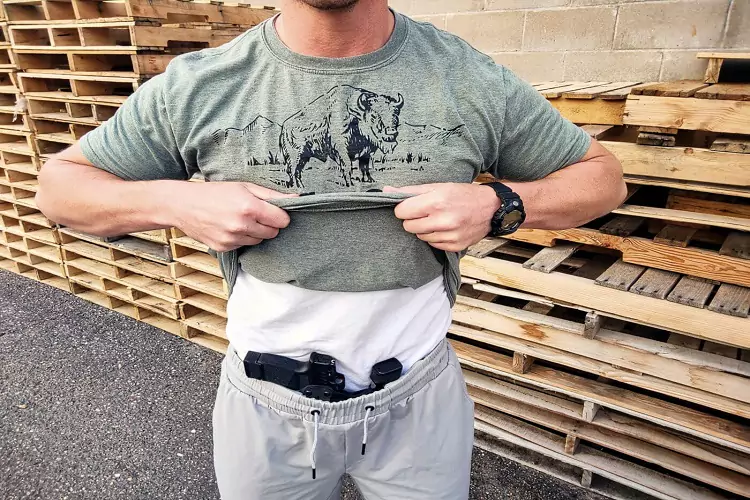Concealed Carry in Athletic Shorts: Comfort Meets Protection
Finding the right balance between comfort and security can be challenging, especially when you want to stay active while maintaining your personal protection. Concealed carry in athletic shorts has become increasingly popular among fitness enthusiasts, runners, and anyone who values both an active lifestyle and personal safety. This comprehensive guide will help you understand everything you need to know about carrying concealed while wearing athletic shorts, from choosing the right gear to understanding legal considerations.
Whether you’re hitting the gym, going for a morning jog, or simply prefer the comfort of athletic wear in your daily life, this article will provide you with practical solutions and expert advice on how to effectively and safely practice concealed carry in athletic shorts.
Why Choose Concealed Carry in Athletic Shorts?
The growing trend of concealed carry in athletic shorts stems from our increasingly active society and the need for personal protection that doesn’t compromise comfort or mobility. Athletic shorts offer unique advantages that traditional pants simply cannot match when it comes to certain activities and lifestyle choices.
Athletic shorts provide superior breathability and moisture-wicking properties, making them ideal for physical activities. Unlike heavy jeans or dress pants, they allow for unrestricted movement during exercise, running, or any physical activity. The lightweight materials used in modern athletic shorts also mean less bulk and better comfort during extended wear periods.
However, the challenge lies in finding effective ways to securely carry a firearm without printing (showing the outline of the weapon) or compromising accessibility. Traditional holster systems designed for belt wear often don’t work well with athletic shorts, which typically have elastic waistbands and lightweight materials that cannot support the weight of a firearm and holster system.
Key benefits of concealed carry in athletic shorts include:
- Enhanced mobility and flexibility during physical activities
- Better temperature regulation and comfort in warm weather
- Reduced bulk compared to traditional clothing options
- Ability to maintain personal protection during exercise routines
- Versatility for both active and casual wear situations
Understanding the Challenges of Athletic Shorts Carry
Concealed carry in athletic shorts presents unique challenges that require specific solutions and careful consideration. The primary obstacle is the lack of a sturdy belt system that most traditional holsters rely on for support and retention.
Athletic shorts typically feature elastic waistbands or lightweight drawstrings that cannot adequately support the weight of a firearm. This limitation means that conventional inside-the-waistband (IWB) or outside-the-waistband (OWB) holsters may not provide the security needed for safe carry. The weight of even a compact firearm can cause athletic shorts to sag, shift, or even fall down, creating both comfort and safety issues.
Another significant challenge is the material composition of athletic shorts. Most are made from synthetic fabrics that are designed to be lightweight and breathable, but these same properties make them less suitable for concealing the outline of a firearm. The thin, stretchy materials can easily show printing, especially when moving or exercising.
Common challenges include:
- Inadequate waistband support for traditional holsters
- Increased risk of printing due to thin, stretchy materials
- Potential for the firearm to shift or move during physical activity
- Difficulty accessing the weapon quickly when needed
- Sweat and moisture affecting both comfort and equipment
Types of Holsters for Athletic Shorts
Selecting the right holster is crucial for successful concealed carry in athletic shorts. Several specialized holster types have been developed specifically to address the unique challenges posed by athletic wear.
Belly band holsters are among the most popular choices for athletic shorts carry. These elastic bands wrap around your torso and can accommodate various firearm sizes while distributing weight evenly. They work independently of your clothing’s waistband, making them ideal for shorts with elastic waistbands. High-quality belly bands feature moisture-wicking materials and multiple carry positions.
Compression shorts with built-in holsters represent an innovative solution that integrates the holster directly into specialized undergarments. These garments feature reinforced pockets or holster systems sewn into compression shorts, providing both support and concealment. They’re particularly effective for runners and gym-goers who want their firearm to move with their body during exercise.
Ankle holsters offer another viable option, though they work best with longer athletic shorts that can provide adequate coverage. Modern ankle holsters designed for athletic wear feature breathable materials and secure retention systems that can handle the movement associated with exercise and active lifestyles.
| Holster Type | Best For | Pros | Cons |
|---|---|---|---|
| Belly Band | General athletic wear | Versatile positioning, weight distribution | Can be bulky, may shift during intense activity |
| Compression Shorts | Running, gym workouts | Integrated design, moves with body | Limited to specific undergarments |
| Ankle Holster | Longer shorts, casual wear | Completely hidden, doesn’t affect waistline | Slower draw, limited to smaller firearms |
| Pocket Holster | Shorts with secure pockets | Simple, no additional gear needed | Requires proper pocket size and depth |
Selecting the Right Firearm for Athletic Shorts
The choice of firearm significantly impacts the success of concealed carry in athletic shorts. Smaller, lighter firearms are generally more suitable for this type of carry, as they place less stress on lightweight clothing and specialized holster systems.
Subcompact pistols are often the preferred choice for athletic shorts carry. These firearms offer a good balance between firepower and concealability while remaining light enough for comfortable carry during physical activities. Popular options include striker-fired pistols that eliminate external hammers and reduce the risk of snagging on clothing.
Pocket pistols represent another excellent option, especially when athletic shorts feature deep, secure pockets with proper holster systems. These ultra-compact firearms are specifically designed for discrete carry and often weigh less than a pound when loaded. However, they typically offer reduced capacity and stopping power compared to larger firearms.
Weight distribution becomes critical when selecting a firearm for athletic shorts carry. Even a few ounces can make a significant difference in comfort and concealment when relying on elastic waistbands or specialized holster systems. Consider the total weight including ammunition when making your selection.
Factors to consider when choosing a firearm:
- Overall weight including loaded ammunition
- Barrel length and overall dimensions
- Reliability and ease of operation
- Capacity versus concealability trade-offs
- Compatibility with available holster systems
Clothing Considerations and Material Choices
The success of concealed carry in athletic shorts heavily depends on choosing the right clothing materials and styles. Not all athletic shorts are created equal when it comes to concealed carry applications.
Fabric weight and opacity play crucial roles in preventing printing and maintaining concealment. Heavier-weight athletic fabrics provide better concealment than ultra-lightweight materials, though they may sacrifice some breathability. Look for shorts made from technical fabrics that offer a balance between weight and performance characteristics.
Pattern and color choices can significantly impact concealment effectiveness. Darker colors and busy patterns help break up the outline of carried firearms, while solid light colors tend to show printing more easily. Camouflage patterns, geometric designs, and textured fabrics all help disguise the presence of concealed firearms.
The cut and fit of athletic shorts also matter greatly. Looser-fitting shorts provide more room for concealment but may not stay in place as well during vigorous activity. Compression-style shorts offer better retention but may show more printing. Finding the right balance requires trying different styles and fits to determine what works best for your body type and carry method.
Optimal clothing features include:
- Medium-weight technical fabrics for better concealment
- Darker colors or busy patterns to minimize printing
- Appropriate fit that balances concealment with comfort
- Quality construction that won’t tear under the stress of carry gear
- Moisture-wicking properties for comfort during activity
Safety Considerations and Best Practices
Safety must always be the top priority when practicing concealed carry in athletic shorts. The unique challenges posed by athletic wear require additional attention to safe handling and carry practices.
Proper holster retention becomes even more critical with athletic shorts carry. Ensure that your chosen holster system provides adequate retention to prevent the firearm from falling out during physical activity. Test your setup thoroughly in controlled environments before relying on it in real-world situations.
Trigger guard protection is absolutely essential. Any holster system used for athletic shorts carry must completely cover the trigger guard and prevent any possibility of accidental discharge. This is particularly important with belly band holsters or pocket carry systems where other objects might come into contact with the firearm.
Regular practice with your athletic shorts carry setup is crucial for both safety and effectiveness. The draw stroke from a belly band or compression shorts holster differs significantly from traditional belt holsters. Practice in various positions and scenarios to ensure you can safely and effectively access your firearm when needed.
Essential safety practices:
- Always use a proper holster that covers the trigger guard completely
- Regularly inspect your carry gear for wear and proper function
- Practice drawing and reholstering in safe, controlled environments
- Be aware of how physical activity might affect your carry system
- Never compromise on quality when selecting carry gear
Legal Aspects of Concealed Carry During Exercise
Understanding the legal implications of concealed carry in athletic shorts is essential for responsible gun ownership. Laws regarding concealed carry can vary significantly between states and even local jurisdictions, and some locations have specific restrictions related to carrying firearms during certain activities.
Permit requirements remain the same regardless of your clothing choice, but it’s important to ensure your permit covers all the locations where you plan to exercise or be active. Some states have reciprocity agreements that allow permit holders from other states to carry, while others do not. Always research the laws in any area where you plan to carry.
Location restrictions may affect where you can legally carry while wearing athletic shorts. Gyms, parks, schools, and recreational facilities may have specific policies or legal restrictions regarding firearms. Some private businesses post signs prohibiting concealed carry, and these restrictions apply regardless of your clothing choice.
It’s also worth noting that some jurisdictions have specific laws about carrying firearms during certain activities. While rare, some areas might have restrictions on carrying while jogging in public parks or using certain recreational facilities. Always research local laws and regulations before carrying in new areas or engaging in new activities.
Key legal considerations:
- Ensure you have proper permits for all carry locations
- Research local and state laws regarding carry restrictions
- Understand private property rights and posted restrictions
- Be aware of any activity-specific regulations in your area
- Consider liability insurance for additional protection
Training and Practice Techniques
Effective concealed carry in athletic shorts requires specialized training that addresses the unique aspects of this carry method. Traditional concealed carry training may not adequately prepare you for the challenges of drawing from a belly band or compression shorts holster.
Draw technique modification is necessary when carrying with athletic shorts setups. The draw stroke from a belly band holster involves different body mechanics than drawing from a traditional belt holster. You may need to lift your shirt with your support hand while drawing with your strong hand, or adapt your technique based on your specific holster configuration.
Movement and retention drills should be incorporated into your training routine. Practice moving, jumping, running, and performing various physical activities while carrying to ensure your setup remains secure and accessible. This type of training helps identify potential problems before they become dangerous situations.
Consider seeking instruction from qualified trainers who have experience with athletic shorts carry methods. Many traditional firearms instructors may not be familiar with the specific challenges and techniques required for this type of carry. Look for instructors who specialize in non-traditional carry methods or have experience training athletes and fitness enthusiasts.
Training recommendations:
- Practice drawing from your specific carry setup regularly
- Include movement and physical activity in your training routine
- Work with qualified instructors familiar with athletic carry methods
- Practice in various clothing configurations and environments
- Focus on safe reholstering techniques specific to your setup
Comfort and Concealment Tips
Achieving optimal comfort while maintaining effective concealment is the ultimate goal of concealed carry in athletic shorts. Several techniques and considerations can help you maximize both aspects of your carry setup.
Body positioning and posture can significantly impact both comfort and concealment. When using belly band holsters, experiment with different carry positions to find what works best for your body type and activity level. Some people prefer appendix carry, while others find 3 o’clock or 4 o’clock positions more comfortable.
Layering strategies can enhance concealment without sacrificing too much comfort. A lightweight, loose-fitting shirt over compression shorts with an integrated holster can provide excellent concealment while maintaining breathability. Consider moisture-wicking undershirts that can help manage sweat while providing an additional layer of concealment.
Activity-specific adjustments may be necessary depending on what you’re doing. Your carry setup for weightlifting might differ from your setup for jogging or casual wear. Having multiple options available allows you to choose the best method for each specific situation while maintaining consistent protection.
Comfort optimization tips:
- Adjust carry position based on your body type and preferred activities
- Use moisture-wicking materials to manage sweat and chafing
- Consider different setups for different types of physical activity
- Pay attention to pressure points and adjust accordingly
- Invest in quality gear that prioritizes comfort alongside function
Popular Brands and Product Reviews
The market for concealed carry in athletic shorts solutions has expanded significantly in recent years, with numerous manufacturers offering specialized products designed specifically for active lifestyles.
ComfortTac has gained popularity for their belly band holsters designed specifically for athletic wear. Their products feature moisture-wicking materials and multiple carry positions, making them versatile for various body types and preferences. The retention systems are designed to handle movement while providing quick access when needed.
UnderTech UnderCover specializes in clothing with integrated holster systems, including compression shorts and other undergarments. Their products are popular among law enforcement officers and civilians who need discrete carry options that work with athletic wear. The quality construction and thoughtful design make them suitable for regular use.
Crossbreed Holsters offers belly band options that have earned positive reviews for durability and comfort. Their modular approach allows users to customize their setup based on specific needs and preferences. The company’s reputation for quality craftsmanship extends to their athletic carry solutions.
When evaluating products, consider factors such as build quality, customer service, warranty coverage, and user reviews from people with similar needs and body types. What works well for one person may not be ideal for another, so it’s important to research thoroughly before making significant investments in carry gear.
Maintenance and Care of Equipment
Proper maintenance of your concealed carry in athletic shorts equipment is essential for both safety and longevity. Athletic activities and environments can be particularly hard on carry gear, making regular maintenance even more important.
Moisture management is a primary concern when carrying during physical activities. Sweat and humidity can affect both holsters and firearms, potentially causing corrosion or degradation of materials. Regular cleaning and drying of all components helps prevent damage and ensures reliable operation.
Holster inspection should be performed regularly, paying particular attention to retention mechanisms, stitching, and material integrity. Athletic activities put additional stress on carry gear, and regular inspection helps identify potential problems before they become safety issues.
Firearm maintenance becomes even more critical when carrying during physical activities. Exposure to sweat, lint from athletic clothing, and environmental factors requires more frequent cleaning and inspection. Ensure that your firearm remains properly lubricated and free from debris that could affect its operation.
Maintenance best practices:
- Clean and dry all equipment after each use in athletic environments
- Regularly inspect holsters for wear, damage, or retention issues
- Maintain firearms according to manufacturer recommendations
- Replace worn or damaged equipment promptly
- Store equipment properly when not in use to prevent degradation
Alternative Carry Methods for Active Lifestyles
While concealed carry in athletic shorts is popular, it’s worth considering alternative methods that might better suit specific activities or personal preferences. Each method has its own advantages and limitations.
Fanny pack carry has experienced a resurgence in popularity, partly due to improved designs and changing fashion trends. Modern tactical fanny packs designed for concealed carry offer quick access and can accommodate larger firearms than some other athletic carry methods. They work well for hiking, jogging, and other outdoor activities.
Backpack carry might be appropriate for certain activities, though it requires careful consideration of accessibility and local laws. Some states have specific regulations about carrying firearms in backpacks, and accessibility can be limited compared to body-worn methods.
Vehicle storage might be the best option for certain activities where body carry isn’t practical or safe. However, this requires understanding local laws about vehicle storage and ensuring proper security to prevent theft.
Each alternative method comes with its own set of considerations regarding legality, accessibility, and security. The best choice depends on your specific activities, local laws, and personal preferences.
Building Your Athletic Carry System
Creating an effective concealed carry in athletic shorts system requires careful planning and consideration of multiple factors. Rather than purchasing equipment piecemeal, it’s often better to develop a comprehensive approach that addresses all aspects of athletic carry.
Start with your most common activities and build your system around those needs. If you primarily jog, focus on solutions that work well for running. If you spend most of your time in the gym, prioritize setups that work well for weightlifting and other gym activities.
Budget considerations should include not just initial purchase costs but also long-term durability and potential replacement needs. Athletic carry equipment often experiences more wear than traditional carry gear, so investing in quality products can be more economical in the long run.
System compatibility ensures that all components work well together. Your chosen firearm should work well with your preferred holster type, which should be compatible with your typical athletic wear. Testing the complete system before relying on it is essential for both safety and effectiveness.
System building steps:
- Assess your typical activities and environments
- Research legal requirements for your area
- Select appropriate firearms and holster systems
- Test compatibility and comfort in controlled settings
- Develop maintenance and training routines
- Consider backup options for different situations
Key Takeaways
Concealed carry in athletic shorts requires specialized equipment, training, and considerations that differ significantly from traditional concealed carry methods. Success depends on choosing the right combination of firearms, holsters, clothing, and techniques that work together to provide both security and comfort during physical activities.
Essential considerations include:
- Selecting appropriate holster systems designed for athletic wear
- Choosing firearms that balance effectiveness with concealability
- Understanding legal requirements and restrictions in your area
- Developing proper training and practice routines
- Maintaining equipment properly for safety and longevity
- Having alternative options for different activities and situations
The growing market for athletic carry solutions provides numerous options, but success requires careful research, testing, and commitment to proper training and maintenance. What works for one person may not work for another, so it’s important to take the time to find the right combination of equipment and techniques for your specific needs.
Remember that safety should always be the top priority, and any compromises made for comfort or convenience should never compromise the basic safety requirements of proper holster selection, trigger guard protection, and secure retention.




![Swimsuit Edition [ABBB] - 1.20 21 Swimsuit Edition - Chapter](https://beczema.com/wp-content/uploads/2025/07/Swimsuit-Edition-ABBB-1.20-21-Swimsuit-Edition-Chapter-768x432.webp)


